It’s interesting how we’re forced to grapple with new concepts whenever words come into the language. For the makers of these words of course it was the other way around. To all of the Incels out there, let me say thank you, thank you, thank you. Thank you for taking one for the team. It’s so heartening to know that your genetic material won’t be passed on.
Autumn Breakfast
I think I’ll have a carrot for breakfast. What do you think about that?
No, a carrot is more of a summer breakfast isn’t it.
I feel like porridge today instead.
written with the light Lesa gave me
5.5.18
Dana (draft/character sketch)
She’d been a journalist more than half her life. A week out of high school she walked into The Albury-Wadonga Border Mail with a handful of photos of Black Springs Creek at the start of a dry spell. A photo of a dried sheep carcass in the middle of the barren creek bed, with the Albury Cemetery in the distance, made it onto the front page. Editor Bob Carlisle asked if she could put a couple of hundred words together to go with the photos. She went home, dug out her old geography text book and began two years of reporting on what would become the drought of the early ’90s. Carlisle had been her mentor ever since.
Then there was a move to Sydney, where she reported for The Herald another two years, while in the evenings she did a diploma in TV production at a dubious private college. In her early twenties she went to
I took out the inverted commas, just to see what it would look like
Tell me about them.
Maybe I will.
She looked around the plane. I just happen to have a few hours. You’ve time for plenty of detail.
He looked back out the window as though gathering his thoughts, but fell into the meditative distance once again, somewhere toward the scraggy backbone of the country.
When he finally returned to his food tray she continued.
Gerome was pretty impressed by the donation you extracted from Liliane Bettencourt.
I didn’t extract anything. I’m bewildered. I think she chose to give me the donation as some sort of gesture, I think because I’m American, I don’t know.
A gesture?
It’ll be put to good use, that’s all that matters
The flight steward came past, filling their coffees.
Madame Montagne and Lilly were out spraying the plants again when I left. Checking to see if you were there again in the morning I’m sure.
Oh? I’m sorry to disappoint them.
She frowned at him sideways and caught his eyes.
Not sorry to disappoint me? she said, holding his gaze.
Les Internationaux (draft first chapter)

This story is dedicated to the journalists and humanitarian aid workers who have died in conflict, giving their lives for a cause.
Felicity stepped back from the gurney where she’d pieced together a shattered metacarpal and ulna, bellowing prescriptions for antibiotics and pain medication at the nurses, and binning another pair of gloves as the patient trundled away. The next patient was brought crying, blood thickening his hair. “Irja sayidati, min qibal allah.” Oh god, please madam. It was the baker from the corner. She looked over the wounds across the upper half of his body, shone her light in his pupils. Most of the trauma was on the inside. Her neighbours would struggle to buy bread tomorrow.
Fallujah, 2004
Chapter 1
Erbil, Northern Iraq, 2008
Hasna al-Jumaili and her two small children had been searching the corridors at Rojawa Hospital after the Ansar al-Sunnar bombing, when the doctor took them aside, offered them water, and phoned around. Hasna endured a sleepless night and another agonising day before the doctor found her husband, a policeman, at nearby Sardam Hospital. He’d survived the bombing, only to be gunned down at a check-point months later. Now Hasna brought Khalil and Jasmeen to say goodbye to Doctor Beauvoir, who’d taken special care of the family ever since.
It was the last consultation of the day. Sitting down, the doctor smiled at the children before removing her hijab, so the children saw her golden hair for the first time. For Doctor Felicity Beauvoir this long war was coming to an end at that very moment. She looked at Jasmeen, whose bright brown eyes shone back. She knew that for this five-year-old, her seven-year-old brother, and their twenty-six-year-old mother, the war wasn’t over.
“How is your arm now?” said Felicity, taking Jasmeen’s arm and examining the spot where she’d delivered a vaccination the last time she’d seen her.
“Innah ‘afdal alan.” It’s better now.
“Thank you for the gift.”
“It’s just small, to say thank you for looking after us,” said Hasna, who’d taken meticulous care preparing orange flavoured basboussa sweets.
“I’m sad to go. Doctor Faraj is a good man. He’ll do a great job taking care of you now,” Felicity said, spreading eye contact among all three of them affectionately, as much to absorb as to reassure. Felicity wanted to burn this image into her. She’d dedicated the four most intense years of her life to the health and wellbeing, indeed the survival of Iraq and its people. The spectacle of these two healthy children and their strong and determined mother was desperately needed reaffirmation. In this long and senseless war there’d been children and mothers for whom her years of training and experience, and the best available resources, had only deepened the sense of helplessness.
Felicity caught Khalil eyeing the basboussa from the opposite end of her desk. Turning her attention with theatrical keenness to the carefully arranged tray of sweets she said, “Wow. These look incredible. Shall we have some?”
She held the plate out for Khalil, who looked for Hasna’s nod before reaching for the one he’d picked out. The three ladies each picked one too, and together they sat and savoured the aromatic sweet.
Memories of things that happened three years earlier came to the surface whenever Felicity saw Hasna and her children. During her time in Iraq there’d been other events as horrific as the suicide bombing that brought them together. It was different though, because at the time, Felicity had just found out that she was pregnant. Hasna and her little family made her think how things might have been. Today was her last day at the NGO’s Erbil clinic, and Felicity was especially prone to rumination.
She’d left her apartment in the city’s Araban quarter early, heading out into waking streets on her bike. Pedalling toward the ancient Hewler citadel with the swelling nostalgia of someone looking for the last time at the place they presently called home, she marvelled that people were actually stirring within its stone walls and buildings, some of them prehistoric. Straddling the mesa at the centre of modern Erbil, the citadel could be seen from just about anywhere. During her time in the Middle-East Felicity had indulged her interest in the ancient world, visiting many sites, but living amid humanity’s oldest continually inhabited settlement was profound.
Construction cranes and communications towers punctuated the surrounding Erbil cityscape optimistically, while down at ground level, parks and gardens dominated by water fountains were a particular preoccupation of the city planners.
She passed the Hewler Governate building with its muraled concrete bomb barriers. Up ahead at the foot of the citadel was a mosaic depicting Alexander the Great’s defeat of the Persian King Darius III at the battle of ‘Arbela’, a practically recent event in the sweep of Erbil history. Just beyond that, around the bend she could see the dome of the Salih Dhabak Mosque, a modest yellow-brick structure she’d thought reminiscent of modern suburban churches in Europe. Felicity soaked it all in one last time.
At the junction before Sultan Muthafar’s Shrine she swung down Barzani Namir Road in the direction of the Erbil International Hotel where she normally began the day with a swim. She waved to Faris, her computer guy, as she passed his store.
The Erbil International Hotel was notorious for its belligerent staff, but she could blend in with foreign patrons and it had a fine swimming pool that was generally empty early in the mornings. She lapped powerfully for twenty minutes and then cooled down at a gentler pace, relishing the gentle resistance of fluid crystal against her free-flowing limbs. Coming to a graceful halt she bobbed serenely for a minute enveloped in that elemental embrace, before climbing out invigorated.
Towelling water from her honey coloured hair, olive skin, and her ocean blue one-piece, Felicity wrapped herself before reaching into her backpack for her iPhone. Her boss, Gerome, had given it to her on his recent visit to Erbil. A former investment banker, after a ‘road to Damascus’ moment, Gerome had turned his considerable wealth and talent to humanitarian endeavours (and subsequently found himself on a literal road to Damascus). The iPhone had recently been named TIME magazine’s invention of the year, he’d told her excitedly. Tech savvy in the manner of a CEO who wanted to be known as tech savvy, he’d enthused with her about the online games, the handy navigation tool, and the quality of the camera and music. Felicity knew that it was really about the applications he’d installed to locate her in the event of emergency.
Gerome had been in Erbil for meetings concerning the transfer of their operation to a local NGO, and to discuss her team’s redeployment. Plans had firmed up in recent days with the escalating fracas in Georgia. Opening her email, Felicity responded to her mother first.
Felicity went into aid work straight out of the Université Pierre et Marie Curie, much to the dismay of her Gaullist father who’d expected her to become a plastic surgeon and live in the apartment he bought her on Rue de Lancry until she married a banker or a politician, but with the blessing of her bohemian mother, who’d pictured her moving to the country and becoming a GP, tending cows and farm dogs as much as to rustic artists and vintners.
Blanche Beauvoir was thrilled at the news that her elegant, accomplished, free-thinking and spirited surgeon-daughter would be returning to Paris. Felicity had been in Iraq saving children, repairing sanitation, and virtually single-handedly turning back the tide of destruction and corruption wrought by George W. Bush and his over-bearing, blundering cohort. This much Blanche had shared with her colleagues at the Fédération Démocratique Internationale des Femme. Felicity’s presence in Paris would be an opportunity for the mesdames to hear first-hand accounts from the frontline in the struggle for global peace and justice. It would also silence that prattling Celeste Gonard, who interrupted Blanche’s reports during the monthly meeting of le Fédération’s Paris chapter, whenever they touched on the detail of Felicity’s emails.
Felicity didn’t know this precise context, but she knew her mother well enough to recognise the tone, which suggested the email was attended by some such significance. Ouimaman, I’ll be in Paris in a couple of days, Felicity confirmed. Oui maman, I would love to come to your dinner party on Saturday, she wrote, but sadly she’d be leaving again before her mother’s meeting next Tuesday.
Felicity turned to an email from the NGO’s Central Asia research team entitled “South Ossetia Briefing”. Among the lines and lines of information on that email, one short phrase in the ‘Cc’ field jumped out: “alan.steiger@…”. Felicity scanned the email and the attached documents without luck to find out Alan’s involvement. She suppressed the impulse to phone Gerome and fish for clues. It was still too early in Paris at any rate. She put her phone away and pondered while she finished towelling off.
She pedalled up to the Qaysari Bazaar for some final souvenirs for her parents and for Madame Montagne, her elderly neighbour in Paris. When she first came to Erbil, Felicity would willingly get lost in the arcades, alleys and shops of the bazaar. Now, as in many pockets of Erbil, she had to circumnavigate construction works, where a colossal shopping mall was being built to the south of the bazaar, and another water-fountain filled parkland was being created at its centre. The noise and dust of heavy machinery did nothing to dampen the activity of the labyrinthine bazaar, into which she wandered.
Textiles, dried figs and apricots, dates and raisins, honeys and cheeses, shoes, the aroma of spiced and sugared sweets and breads, kebabs and tikka, tea-rooms with walls covered in framed photographs of heroes and patriarchs stretching back 100 years, and Kurdish music from within. Furniture stores, Chinese made clothes, toy stores and fresh fruit, Turkish made clothes, jewellery both handmade on site and imported, make-up both traditional and imported, walnuts, in some places beneath spectacular ancient domed ceilings and in other places beneath corrugated iron, where shoppers and sellers milled about like bees in a hive. Rich and fragrant spices in piles of oranges and yellows, browns and greens. Kurdish fabrics inlaid or embroidered with with gold fibres, household cleaning products, carpets and antiques, nuts roasting, gaudy clocks and watches, stationery and currency, stall holders and customers communicating in both Kurdish and Arabic, in the same conversation. Pomegranate seeds, guitars and drums, and cushions on which to sit and play them.
At a stall where a vendor enticed buyers to his syrupy sweets with cries of “kaka kaka”, Felicity heard an email ping into her backpack like some arrow fired from Paris with a message tied around it. She reached in for the iPhone, a message from Gerome, her eyes went to the ‘Cc’ field. She and the rest of the Erbil crew were to convene upon Istanbul early next week to begin stock-piling a new operation before freighting it and themselves to Georgia. Alan Steiger, named chef de mission, was already on his way to Tbilisi to make political and administrative arrangements. Like some arrow fired from across the sea it struck.
Her mind drifted to a Doha hotel room three years earlier, where she’d sat by the window looking gloomily across the skyline. Alan was packed and their few days of imagined bliss over. She’d wanted to tell him his marriage was doomed, Elizabeth didn’t love him, and was probably goading him leave her, sad fool that he was. She’d wanted to say she’d fly with him to New York, go with him to Juba, take him back to Erbil. She’d wanted to say stay with her, in that hotel room. Instead she rose, crossed the room and held him close to all that she’d given him, and kissed him tenderly.
Kaka, kaka, said the sweets vendor tentatively, to the woman who appeared lost.
A late July heat haze was already settling over Erbil as she left the Qaysari Bazaar. She headed back in the direction of Araban to meet Doctor Faraj at the Directorate of Health.
The Directorate was located a few streets from the NGO’s clinic in a nondescript three-storey office building typical of regional administrations throughout the world. Felicity could have been walking into a provincial medical bureaucracy anywhere, if it weren’t for the two-and-a-half metre tall muraled concrete bomb shields surrounding it, the checkpoint she had to navigate, and the guards in peshmerga camouflage brandishing AK47s at every doorway. In some places they outnumbered staff. She crossed the short foyer and signed for a visitor pass at the reception desk, where she was greeted with a familiar smile. “Doctor Beauvoir, Doctor Faraj is expecting you”.
Summoned by the building’s PA system, Doctor Faraj appeared at a corner of the foyer from an entryway framed by office issue ficus and fatigues. “Doctor Beauvoir, thanks for coming.”
She followed him down the corridor to a small room which he’d claimed as his office for the day. He apologised that he’d found two chairs but no desk. Faraj, a refugee in the 90s, had studied in the UK before returning to his native Kurdistan after the fall of the Baathist regime. Thus displaced from his family’s traditional patrons, he was so far unable to find a place in the Kurdish establishment, but found instead a place in local civil society. Felicity calculated his age at a couple of years younger than herself, in his early 30s, but he looked ten years older, with an emerging pot-belly, receding hairline, grey bags behind his spectacles, and a frown creased permanently above them. To Faraj, taking charge of the NGO’s clinic was the greatest opportunity of his life. He’d been at the clinic the past month practicing medicine with the NGO. However, transforming it into a local practice run by a citizen required endless documents to be lodged with the Directorate of Health.
“Here are the maintenance agreements and warranty for the ECG machines, the X-ray, two sterilisation units,” Felicity explained, taking several folders from her backpack. “An inventory of the pharmacy.” Faraj nodded as they both looked at the documents passing from her backpack across his lap and into his satchel.
“I’ll be around tomorrow in case you need me. You have my email and my number,” she said. A moment’s pause, and they both smiled.
“Thank you,” he said. “Your patients are in good hands.”
“I know.” She looked around the freshly painted empty room, a vessel to be filled, nothing but potential, like Faraj himself. Peshmerga fatigues, sub-machine guns, and bomb-shields suffocating government buildings were a pall over the transaction taking place.
Felicity stepped over to a window where above the concrete barriers she could see the citadel in the distance. Seven thousand years of civilisations coming and passing. Is this what she was witnessing? Had she truly been here at a moment of such transition?
“What’s the prognosis, do you think, of this troop surge, and the US election?” she asked, looking now at the deep blue sky beyond the citadel, into which she was already beginning to disappear.
“Even if Obama does win he’ll have to continue Bush’s troop surge. The other choice is a vacuum,” said Doctor Faraj distractedly, still seated, perusing documents on his lap. “As much as I hate to admit it, we need the Americans to stay.”
They looked at each other a moment, thoughtfully, and he joined her at the window. “Thank you for everything, Doctor Beauvoir. Whatever happens from now, some of it’s in our hands, and some of it is not.”
He shook her hand as she left to begin her last day caring for patients who tomorrow were his to care for.
After saying goodbye to Hasna al-Jumaili and her two kids with hugs and exchange of email addresses, Felicity sat down to return a call from Paris.
“’ello,”
“Gerome, c’est Felicity. You called?”
“Ah, Felicity, thanks for phoning back. I just wanted to touch base and make sure you’re okay with the new mission. ”
“Thanks Gerome. I think we’re all excited at the prospect.”
“Très bien.” Gerome paused, as if considering how to continue. “This is not like 2005, you know. We’re not abandoning them, scampering back to Amman to save our skins and leave the Iraqis to their fate. We’re handing it back to them.”
“I fear this thing will escalate before it’s through, and there’ll be more bloodshed. But it’s okay, Gerome, I’m ready to move on.”
“I’m relieved.” Gerome hesitated again before continuing. “You know, he asked for you.”
There was a heavy pause.
“As I said, Gerome, I’m ready to move on.”
the first edition CAN BE PURCHASED by clicking HERE
The Imaginary Japanese
It’s okay, you can go in there, he said, with profuse nodding and smiling, unlocking the gated enclosure and gesturing for me to enter. His rake in one hand, a crisp blue shirt tucked neatly into the fawn gabardine of the retired salaryman, narrow-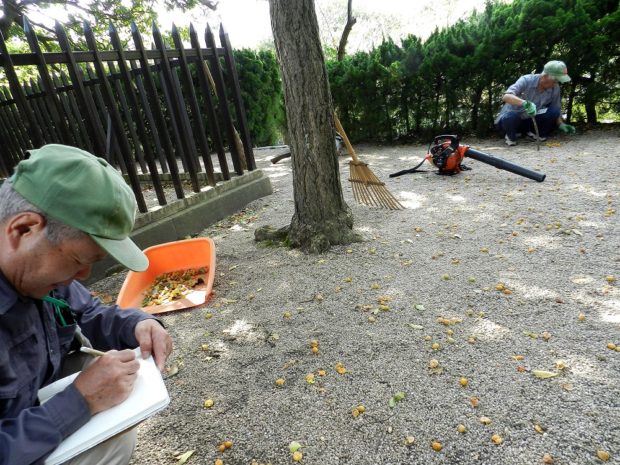 brimmed cotton hat and gardening gloves impeccable despite the pile of leaves he and his buddy had amassed. ‘Kaba Kuneguchi’, he would write in my notebook, ‘September 30th, Heisei 23’ (2011), in hiragana to make it easy for the gaijin. I’d been circling the Miura Anjin memorial for ten minutes taking photos from outside the tall iron fence. Kaba was a volunteer with the Tsukuyama Park Preservation Society. Officialdom. It was okay.
brimmed cotton hat and gardening gloves impeccable despite the pile of leaves he and his buddy had amassed. ‘Kaba Kuneguchi’, he would write in my notebook, ‘September 30th, Heisei 23’ (2011), in hiragana to make it easy for the gaijin. I’d been circling the Miura Anjin memorial for ten minutes taking photos from outside the tall iron fence. Kaba was a volunteer with the Tsukuyama Park Preservation Society. Officialdom. It was okay.
I grew up in an Australia ambivalent toward the Japanese. Our grandparents had faced them in conflagration. In the 70s, when the dominance of local, British and American manufactures was overwhelmed by more available goods from Japan, ‘Jap crap’ entered the vernacular, referring to anything cheap or lacking quality. If I’d had an amoebic concept of the Japanese as a kid, that was all I knew.
Somewhere in my mid-teens, amid my awakening social and political consciousness, two things happened which ended any ambivalence I might have absorbed. Firstly, my grandfather opened-up about his wartime experiences, and I learned that despite the lingering fallout of wartime propaganda and its effect on some Australians, the attitudes of the old warriors themselves could be far from negative. They’d seen the suffering of Japanese alongside their own. They’d seen evil committed by all sides. What they’d fought for and won was peace, not lasting, purposeless hatred.
 Around that time, I read Trevanian’s Shibumi, a broad, brooding novel. Shibumi revealed to a fifteen-year-old that there are alternative frames through which to look at the world, and that all knowledge is refracted by the conduits through which it’s conveyed. The novel also introduced me to the excitement of the political thriller. Protagonist Nicolai Hel was born in Shanghai to an exiled White-Russian mother, and raised in Japan by a surrogate father, General Kishikawa of the Imperial Japanese Army. It’s this upbringing, with an acute sensitivity to custom, honour, the aesthetic, and clean, lethal violence, that would equip Nicolai for a career as an international assassin.
Around that time, I read Trevanian’s Shibumi, a broad, brooding novel. Shibumi revealed to a fifteen-year-old that there are alternative frames through which to look at the world, and that all knowledge is refracted by the conduits through which it’s conveyed. The novel also introduced me to the excitement of the political thriller. Protagonist Nicolai Hel was born in Shanghai to an exiled White-Russian mother, and raised in Japan by a surrogate father, General Kishikawa of the Imperial Japanese Army. It’s this upbringing, with an acute sensitivity to custom, honour, the aesthetic, and clean, lethal violence, that would equip Nicolai for a career as an international assassin.
A few years later I saw rallies protesting Japanese investment in real estate draw 1500 people on the Gold Coast, while The Canberra Times reported that Japanese were fourth on the ranking of foreign investors in Australian real estate, behind the UK, the US and New Zealand.
Then in the early 90s a Japanese girl approached me at university and asked for directions, and my hereto vague awareness of Japan became a love affair with Japan.
The gate was open, and I walked through.
*
Shibumi was the first of many novels written by Westerners about the Japanese that I’ve relished. As I write, within eyesight are both Shibumi and its sequel, Satori, a homage to Trevanian authored by Don Winslow. There’s The 47 Ronin Story by John Allyn, Tokyo Year Zero by David Peace, Rendezvous at Kamakura Inn by Marshall Browne, and Shogun by James Clavell. Liza Dalby’s The Tale of Murasaki is missing from my bookshelf, borrowed by some book-louse without the class to return it.
Shibumi aside, I don’t think any of these have been pronounced works of literary genius. There are famed Japanese authors on my bookshelf, both in Japanese (property of my spouse, Chizuru) and in translation. However, it’s this type of Westerners’ imaginary Japan more than Japan’s own literature that hooks me. It’s a guilty pleasure, because somewhere in my schooling are Edward Said’s Orientalism, and Alison Broinowski’s The Yellow Lady: Australian Impressions of Asia. My cherished novels exoticise, romanticise and distort the Japanese in some of the ways my liberal education would disparage. Worse still, I detect orientalist traits in my personal life, which can muddle things in a fifty per cent Japanese household.
Some of these novels are based on historical people, and in 2011, during a visit to the in-laws, I took an excursion with my new camera to locate them.
I’d been enraptured by Liza Dalby’s The Tale of Murasaki. Murasaki Shikibu, who lived a thousand years ago, is remembered for authoring The Tale of Genji, often  credited as the world’s first novel, and for her poetry and her diaries which provide a
credited as the world’s first novel, and for her poetry and her diaries which provide a
titillating exposé of Heian era court culture. James Clavell’s Shogun was also fresh in my memory. I was inspired to read it after catching a re-run of the TV miniseries. Shogun is based on the life of Englishman, William Adams, known to the Japanese as Miura Anjin, who settled in Japan four hundred years ago.
I set forth to see what traces I could find of these two characters in 2011.
* *
Yokosuka, 30 September 2011
Having wandered into Tsukuyama Park in the city of Yokosuka at the southern end of Tokyo bay, I was drawn to a broad granite staircase that, from the bottom, gave no clue about where it led, only that such an imposing set of stairs had to be going somewhere important. Approaching the top, directly ahead two cenotaphs on a dais rose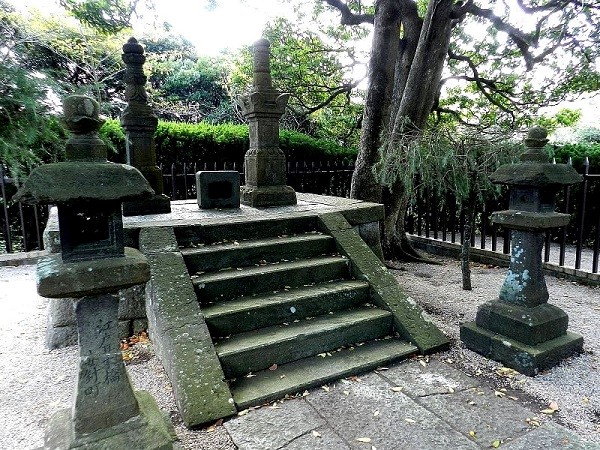 into view, abstract forms in stone and yet full of humanity. One, with fluid edges and floral suggestions, was unmistakably feminine, the other, sharper edged with less organic accents, discernibly male. Here stood a man and woman in timeless consort. Side by side and full of vigour, the immigrant samurai and lady of Hemi overlooked their fief, and beyond it in the distance the metropolis once known as Edo. I’d stumbled across the mossy cenotaphs of Miura Anjin (William Adams) and Magome Oyuki. My guide map was in Japanese so I’d somehow not anticipated them, though I’d been following Adams’s trail. I wasn’t sure what I was looking for when I’d set out to find what I could of William Adams, but I knew this was it. Like Adams, and James Clavell’s John Blackthorne, I’d fallen in love with a Japanese. Like Adams and Blackthorne I’d fallen in love with the Japanese. In form and placement these
into view, abstract forms in stone and yet full of humanity. One, with fluid edges and floral suggestions, was unmistakably feminine, the other, sharper edged with less organic accents, discernibly male. Here stood a man and woman in timeless consort. Side by side and full of vigour, the immigrant samurai and lady of Hemi overlooked their fief, and beyond it in the distance the metropolis once known as Edo. I’d stumbled across the mossy cenotaphs of Miura Anjin (William Adams) and Magome Oyuki. My guide map was in Japanese so I’d somehow not anticipated them, though I’d been following Adams’s trail. I wasn’t sure what I was looking for when I’d set out to find what I could of William Adams, but I knew this was it. Like Adams, and James Clavell’s John Blackthorne, I’d fallen in love with a Japanese. Like Adams and Blackthorne I’d fallen in love with the Japanese. In form and placement these 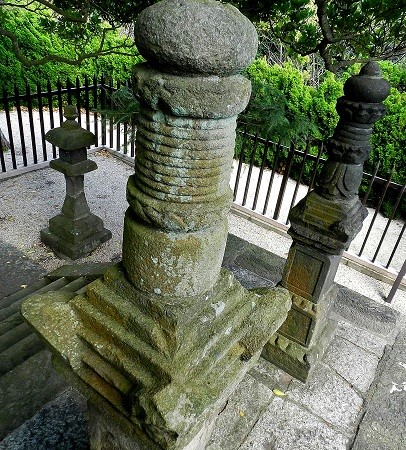 cenotaphs eloquently captured Adams and
cenotaphs eloquently captured Adams and
Oyuki in memorial, while in aspiration they captured me.
Four hundred years ago, favoured by shogun Tokugawa Ieyasu, Adams was elevated from stranded foreign sailor to Japan’s highest nobility. Forced to leave his life in England behind, including a wife, he’d remarried to Oyuki, a woman of modest social status, out of love.
In James Clavell’s novel based on Adams’s life, protagonist Blackthorne falls for married noblewoman, Mariko, whose reciprocation would’ve resulted in both their deaths. Eventually resolved to be together, Mariko dies during the novel’s version of the Battle of Osaka, an event at which the real Adams was present.
Mariko’s passing in Shogun is a dramatic climax that tortures the reader with ‘what ifs’. ‘No, this can’t be happening,’ you’re thinking, as you will the character back to life, at the same time delighting in the tragedy of it.
Alison Broinowski points out though, that this is a common trope in Western imaginative discourse on the orient. She calls it the ‘Butterfly Phenomenon’, after Puccini’s tragic heroine.
An Eastern woman may be delightful, but she cannot become a Western wife, and her child is a half-breed. After her day in the sun with her lover, Cho cho san will pay the price of pleasure: her wings will fade, and she will perish. She is a fragile art object, but also a cheap, replaceable commodity.
Broinowski
Privately, I must confess to… let’s just say a slight moistening of the eye as Blackthorne’s Mariko receded on her funeral pyre, farewelled in her white kimono, like Chizuru wore on our wedding day.
Despite the outcome for Clavell’s Mariko and Puccini’s Cho-cho san, in the case of the real life Oyuki Magome, there was no reunion with the Western woman. Adams chose life with Oyuki.
Sunpu Castle, Shizuoka, 1 October 2011.
Tokugawa Ieyasu is as revered by the Japanese as a statesman can be. In the West, his profile would approximate a Julius Caesar. He’s the figure who provided the title for Clavell’s novel, ‘shogun’ being the name given to a hereditary military dictatorship which, when secured by Tokugawa in battle in 1600, signalled the beginning of Japan’s Edo Era.
Adams sometimes came to visit  his benefactor, Tokugawa, in his retirement at Sunpu. Within Sunpu Castle Park survives a sprawling mandarin tree, planted by Ieyasu, that it’s easy to imagine could have borne fruit that Adams tasted.
his benefactor, Tokugawa, in his retirement at Sunpu. Within Sunpu Castle Park survives a sprawling mandarin tree, planted by Ieyasu, that it’s easy to imagine could have borne fruit that Adams tasted.
The castle’s been restored to its Tokugawa specifications, and there are displays of military artefacts and tactics of the day. In Clavell’s novel, Ieyasu’s avatar, ‘Lord Toranaga’, represents the pinnacle of the samurai class. The samurai, and concepts like bushido, ‘harakiri’, ninja, the katana (Japanese 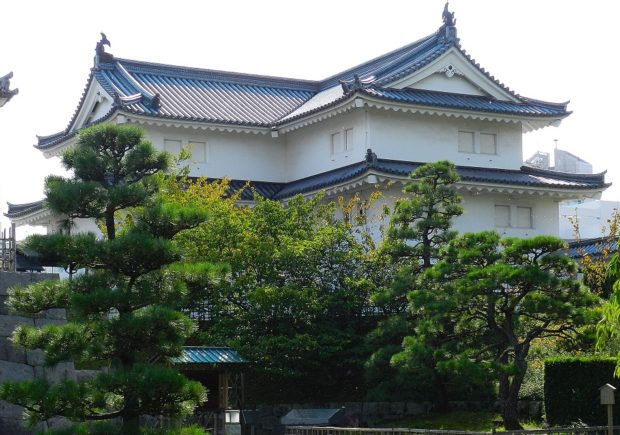 sword) and its vicious application, are preoccupations in Western imagery of Japan. They coincide with the orientalist notion of the savage, inscrutable, deadly ‘other’. Some Japanese will chuckle at this Western preoccupation, and it marks one as a ‘hen-na-gaijin’ (silly foreigner). I must keep my curiosity about these things in the closet.
sword) and its vicious application, are preoccupations in Western imagery of Japan. They coincide with the orientalist notion of the savage, inscrutable, deadly ‘other’. Some Japanese will chuckle at this Western preoccupation, and it marks one as a ‘hen-na-gaijin’ (silly foreigner). I must keep my curiosity about these things in the closet.
All the same, I can’t help having some fun with our imaginary Japanese traits. My son Bryce and I are co-conspirators. When Chizuru’s cross with one of us, we might whisper to each other in mock horror, “They chop people’s heads off”. I told my dad 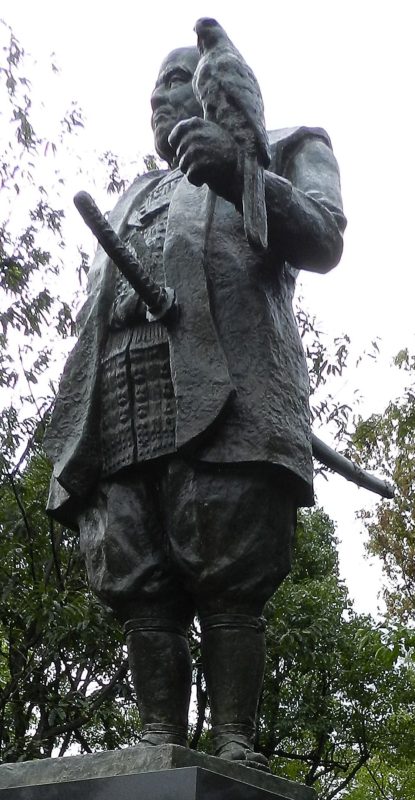 once, who was being a rogue, “She won’t say anything. She’ll just hand you the wakizashi,” (the short sword with which one performs seppuku).
once, who was being a rogue, “She won’t say anything. She’ll just hand you the wakizashi,” (the short sword with which one performs seppuku).
Do we sometimes fail to differentiate the historical other when it comes to another’s
culture? There are plenty of Japanese who themselves like cultivating this aspect of their history. Are we simply sharing that veneration? Does it mirror a romanticisation with our historical selves? Adams’s contemporaries in the West included William Shakespeare, Miguel Cervantes, and fellow adventurer, Captain John Smith, who co-habited with the natives at Jamestown, the first English settlement in America, at the same moment as Adams in Japan.
Ito, Izu Peninsula, 1 October 2011.
I made it to Ito on dusk, where Tokugawa put Adams to work building a European style ship. Deep in the Izu peninsula, Ito was away from the prying eyes of Tokugawa’s enemies. Though Adams had studied shipbuilding, he’d never actually done it. He was a pilot and navigator. Fortunately for Adams, among the survivors of the Liefde, the ship 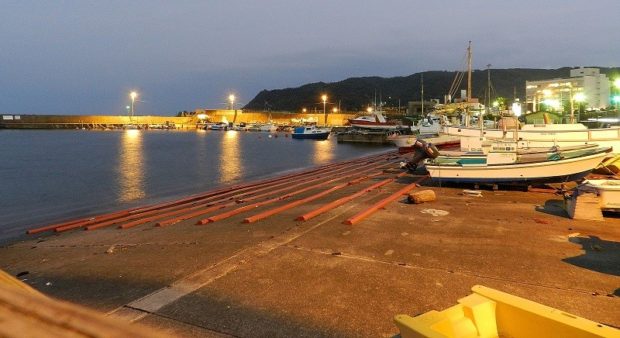 on which they’d drifted wretchedly into Japanese waters, was Pieter Janszoon, her shipwright. In Shogun, Lord Toranaga has Blackthorne’s successfully constructed first ship destroyed, breaking his hopes of sailing home to England. Another trope: the wily, manipulative oriental.
on which they’d drifted wretchedly into Japanese waters, was Pieter Janszoon, her shipwright. In Shogun, Lord Toranaga has Blackthorne’s successfully constructed first ship destroyed, breaking his hopes of sailing home to England. Another trope: the wily, manipulative oriental.
Standing here in twilight in October 2011 looking toward the headlands at either end of the bay, with its distinctive rocky outcrop off to the southeast, I knew that despite the concrete, cars, and electric lights, Adams would probably recognise this place
today. The thought brought him that much closer to me. When he produced his first ship here in 1604, Japan was on the cusp of a new epoch, and Adams was part of its foundation.
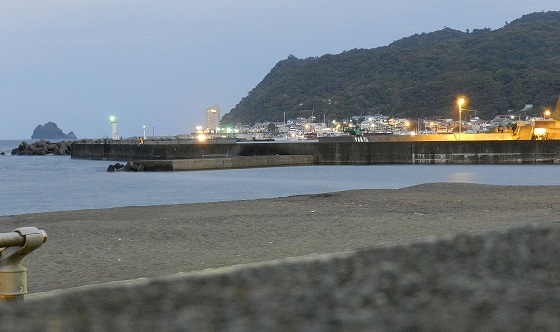
The harbour of Ito on the Izu Peninsula, where William Adams shared his knowledge of European shipbuilding with Tokugawa Ieyasu.
Otsu, 2 October, 2011.
In Liza Dalby’s novel, it’s from the southern shore of Lake Biwa that Murasaki Shikibu embarks with her father for his posting as Governor of Echizen. She’s of 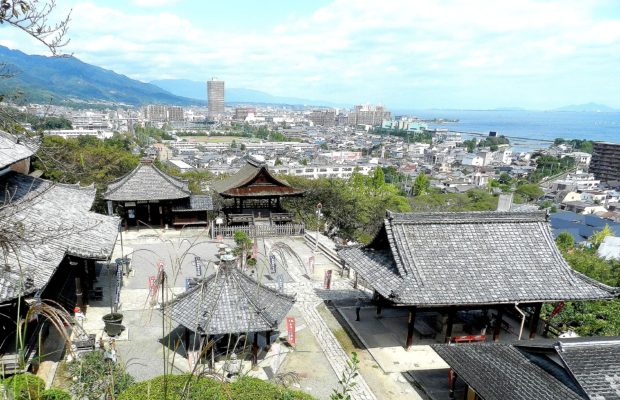 marriageable age and should be staying behind in the society of the capital, but she’s adventurous. She’s cultured in Chinese writing and its venerated forms of poetry, and she can go toe-to-toe with anyone in its customary use as word-sport. In her novel, Dalby explores this in her portrayal of a historical visit by a Chinese delegation to Echizen.
marriageable age and should be staying behind in the society of the capital, but she’s adventurous. She’s cultured in Chinese writing and its venerated forms of poetry, and she can go toe-to-toe with anyone in its customary use as word-sport. In her novel, Dalby explores this in her portrayal of a historical visit by a Chinese delegation to Echizen.
I stand on the pier at Otsu’s ferry station looking over the lake, imagining their boat out amid the water craft approaching the distant shore.
Legend has it that Murasaki conceived of The Tale of Genji at Ishiyama-dera temple in Otsu, where she’d come in retreat. I wonder if it was after the early death of her husband, or during her pregnancy before their daughter’s birth. In later life she returned to Ishiyama-dera in retirement to devote herself to writing and religion. At the temple, they maintain at least one Buddhist scroll in her handwriting.
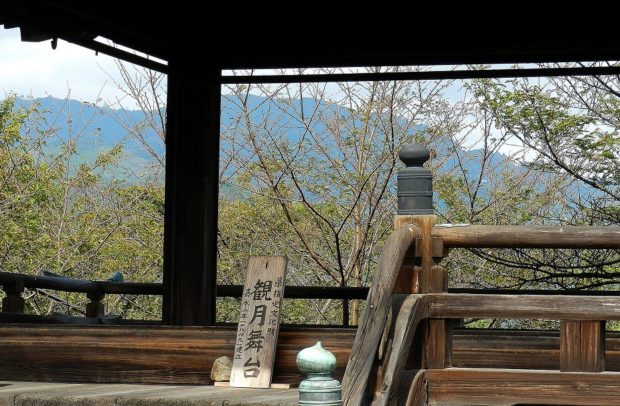
I’d bought some textured washi paper and a writing brush at the Oji Paper Museum, but I’d left them in Tokyo. I made do with the least ordinary paper I could find in a nearby convenience store, and like Genji, wrote a poetic thank you note for my hotel receptionist, Ms Ito. The note remains among the papers I brought back from that trip, undelivered.
Kyoto, 4 October 2011.
The family had caught up with me, and Bryce was pestering me to take him to the Gokouyu onsen, which was apparently something special. Eleven at the time, Bryce loved the Japanese bath-house. I got dragged along.
The onsen was extensive, and Bryce’s enthusiasm for the steamy cleansing atmosphere was infectious. We scrubbed, rinsed, and when I went to dip into one of the baths, a dad jumped up startled, grabbing his two kids by the arms in hasty escape. Oh dear, is this some sort of ‘hairy gaijin’ thing?
Bryce and I bobbed around the inexplicable variety of hot, cold, warm, and cool baths.
“Hey Otto-san, come and try this one,” he squeaked in excitement. He badgered me over and watched with a grin as I dipped into the bath.
What
What tha’
Was that?
I’d experienced this once before in the shower at the Tamworth football grounds, where there was an electrical wiring problem in the visitors’ sheds. “Ow!” My shock was “Ow,” apparently very “Ow” amusing to Bryce. What sort of sadist made a bath that gave measured electric jolts, and why would anyone get in it?
This was not like John Blackthorne’s bath in Shogun! The Sixteenth Century Englishman, Blackthorne had to be coerced into the bath. However, once he learned that the very pleasant Lady Mariko would join him, Blackthorne quickly realised the reinvigorating benefits of the onsen. Again, Broinowski frowns on this kind of ‘observation’ about the curious nuances of openness and modesty among Asiatic females.
Kyoto, 5 October 2011
Rozan-ji, in the garden of Murasaki Shikibu.
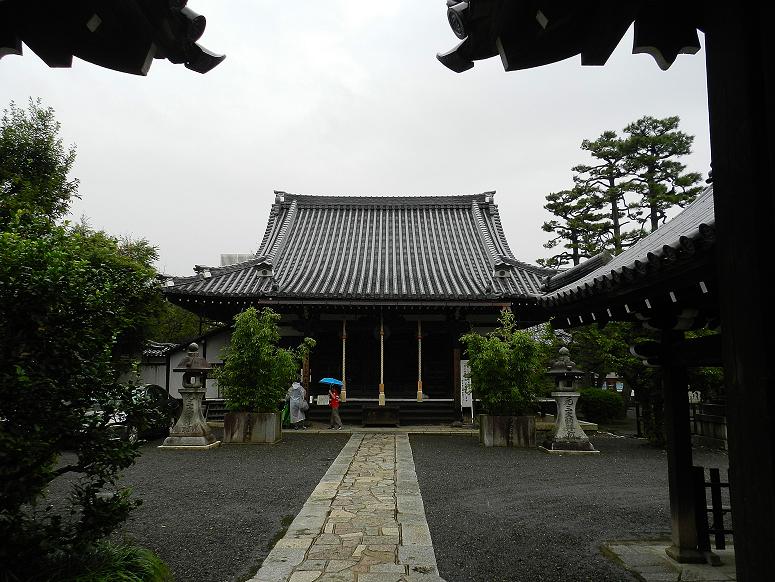 It’s most likely here a thousand years ago that Murasaki Shikibu wrote the first part of the Tale of Genji. It’s the site once occupied by the Tsutsumi-chunogon mansion, built by Murusaki’s great-grandfather, Fujiwara Kanesuke. Murasaki was born at Tsutsumi-chonogon and lived much of her life here. Her marriage in 998 was cut short by the death of her husband, Nobutaka, three years later. She moved from here to the court of the Heian imperial palace in about 1005 at the behest of regent, Fujiwara Michinaga, becoming lady-in-waiting to Empress Shoshi.
It’s most likely here a thousand years ago that Murasaki Shikibu wrote the first part of the Tale of Genji. It’s the site once occupied by the Tsutsumi-chunogon mansion, built by Murusaki’s great-grandfather, Fujiwara Kanesuke. Murasaki was born at Tsutsumi-chonogon and lived much of her life here. Her marriage in 998 was cut short by the death of her husband, Nobutaka, three years later. She moved from here to the court of the Heian imperial palace in about 1005 at the behest of regent, Fujiwara Michinaga, becoming lady-in-waiting to Empress Shoshi.
In her fictional account, The Tale of Murasaki, Liza Dalby depicts Michinaga having his way with Murasaki, without invitation and without protest.
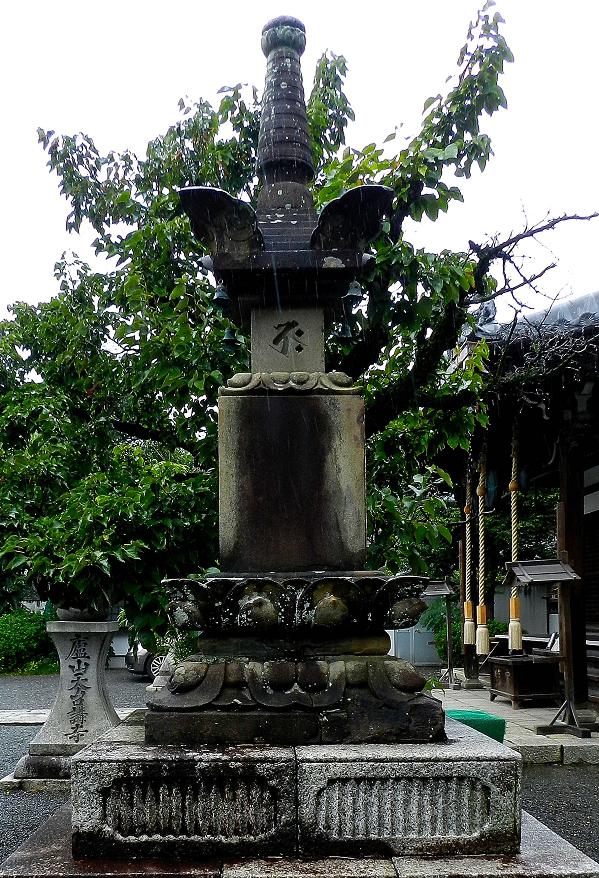
It’s not so much the rape that Broinowski might draw attention to, as the compliance of the oriental female in the Western imagination.
For the past 400 years Rozan-ji temple has occupied the site of Murasaki’s former home. 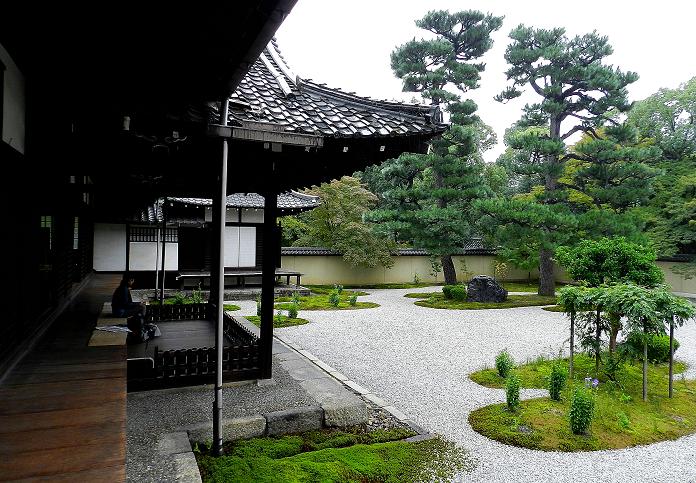 To sit and look over the Genji Garden, established in 1965, is to surrender your thoughts to a life lived on this spot a thousand years ago.
To sit and look over the Genji Garden, established in 1965, is to surrender your thoughts to a life lived on this spot a thousand years ago.
Yet, if spied, it’s the hidden inner garden of Rozan-ji, less grand, that inspires the imagination most. How long has this little stone bridge been here? Wouldn’t Lady Murasaki have trod that same path herself? In those years following her husband’s 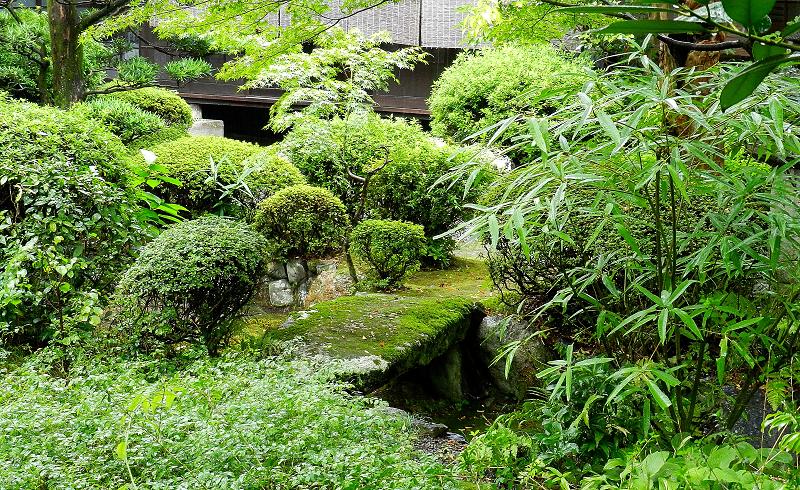 death, when she turned her energies cathartically to her Genji monogatari, would she not have put aside her writing brush sometimes and, eyes cast over this very garden in its seasons, have meditated on the transience of life and love? In this earth are there not still traces of her incense, on the wind not faint reverberation of her poems?
death, when she turned her energies cathartically to her Genji monogatari, would she not have put aside her writing brush sometimes and, eyes cast over this very garden in its seasons, have meditated on the transience of life and love? In this earth are there not still traces of her incense, on the wind not faint reverberation of her poems?
The Sepulchre of 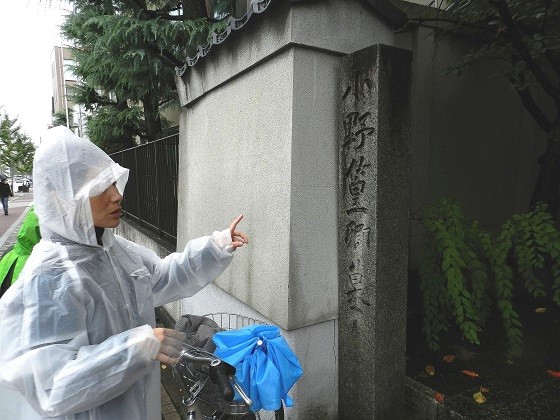 Lady Murasaki
Lady Murasaki
We’d cycled in the rain through Kyoto streets, our destination the final resting place of Murasaki Shikibu. “It’s around here on the map,” I said.
I think we rode past it and turned back.
“Oh, hang on, it’s here.”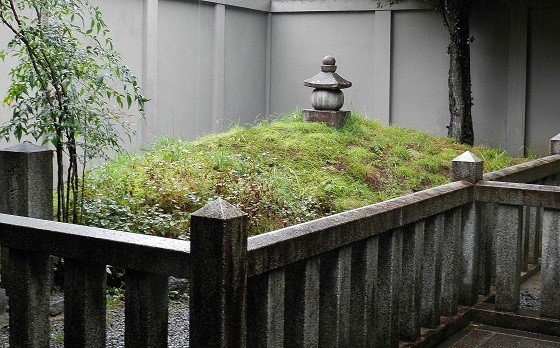
Down an unassuming footpath off Horikawa-dori, a kilometre north of where the
Heian era imperial palace had stood, I’d come into the physical presence of my heroine. Was it her bodaciousness in doing other than expected from a woman of her era; learning, marrying at a time of her 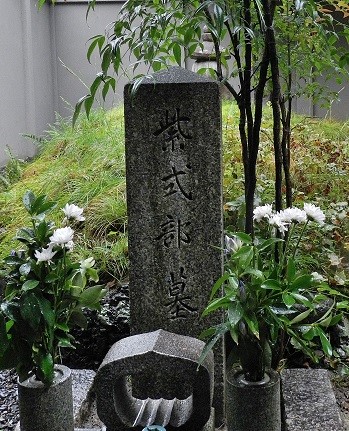 choosing? Taken by her stories of lustful encounters, and the underlying loneliness and yearning in her own story, I was enamoured with a woman who’d been dead a thousand years. Was she an orientalist ideal I sought in my Japanese wife? Am I another Westerner romanticising the exotic, unable to distinguish the temporal other?
choosing? Taken by her stories of lustful encounters, and the underlying loneliness and yearning in her own story, I was enamoured with a woman who’d been dead a thousand years. Was she an orientalist ideal I sought in my Japanese wife? Am I another Westerner romanticising the exotic, unable to distinguish the temporal other?
There I was looking at a sepulchre on a rainy day in Kyoto, scanning the surface of every rock carved in her honour, marvelling at the idea of being where Murasaki lay.
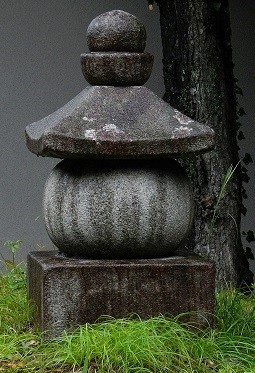
Biwa store, Kyoto 6 October 2011
The biwa is a mandolin-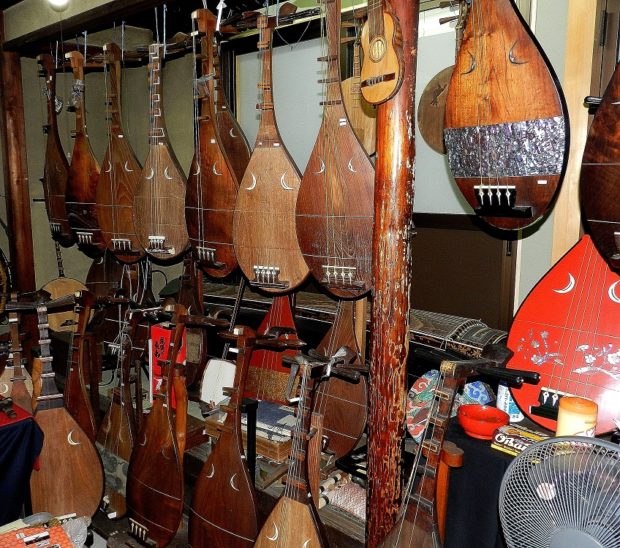 shaped stringed instrument, an instrument played by Murasaki’s protagonist, Genji, and Murasaki herself. On a suburban back-street we came across an antique store with battered biwa hanging from the walls and rafters in various states of disrepair. It’s the neighbourhood where, indelibly, I’d exchanged glances with a Maiko more than a dozen years before. Now that I think of it, it was during that visit to Japan that I met my wife, Chizuru.
shaped stringed instrument, an instrument played by Murasaki’s protagonist, Genji, and Murasaki herself. On a suburban back-street we came across an antique store with battered biwa hanging from the walls and rafters in various states of disrepair. It’s the neighbourhood where, indelibly, I’d exchanged glances with a Maiko more than a dozen years before. Now that I think of it, it was during that visit to Japan that I met my wife, Chizuru.
I linger in the store, trying to recall references to the Biwa in The Tale, like
It happened on a cool summer evening that Genji was sauntering round the Ummeiden in the palace yard. He heard the sound of a biwa proceeding from a veranda. It was played by this lady. She performed well upon it, for she was often accustomed to play it before the Emperor along with male musicians. It sounded very charming. She was also singing to it the “Melon grower.”
“Ah!” thought Genji, “the singing woman in Gakshoo, whom the poet spoke of, may have been like this one,” and he stood still and listened. Slowly he approached near the veranda, humming slowly, as he went, “Adzmaya,” which she soon noticed, and took up the song, “Do open and come in!”
Chizuru’s bored, and getting impatient. I look at her in dismay. Just when is this woman going to begin exchanging poetry with me? Perhaps if I build that tatami room she’ll rediscover her koto and play for me after our evening bath, until we end like Genji and his Fujitsubo.
* * *
Nihonbashi, Tokyo, 8 October 2011.
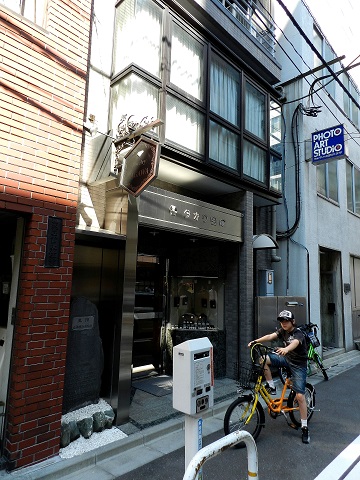 Bryce and I cycle down to the site of Miura Anjin’s mansion in Nihonbashi, where there’s a little stone memorial, well-tended. We head over to the imperial palace, and circle the giant statue of fourteenth century samurai,
Bryce and I cycle down to the site of Miura Anjin’s mansion in Nihonbashi, where there’s a little stone memorial, well-tended. We head over to the imperial palace, and circle the giant statue of fourteenth century samurai, 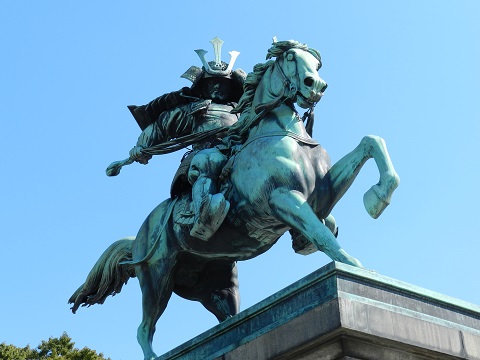 Kusunoki Masashige, on horseback. We pass an oversized motor-scooter with blue flake-metallic paint and chrome to excess. It’s a Harley Davidson parody, incurably Japanese, and its swept back styling oddly mirrors the stance of Masashige’s thundering steed.
Kusunoki Masashige, on horseback. We pass an oversized motor-scooter with blue flake-metallic paint and chrome to excess. It’s a Harley Davidson parody, incurably Japanese, and its swept back styling oddly mirrors the stance of Masashige’s thundering steed.
Unlike me, Bryce’s experience won’t be one of ‘encounter’ with another culture. The challenge will be owning, and being the custodian of two, dividing his energies between tending, like Kaba Kuneguchi at Tsukuyama Park, to both. He’ll become not merely the gatekeeper for two worlds, but the gate between them.
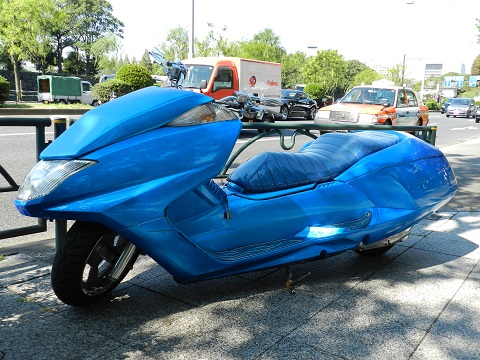
Photographs
More photos capturing the world of Murasaki Shikibu here.
More photos capturing the world of William Adams here.
References
Bowring, Richard and Shikibu, Murasaki. Murasaki Shikibu, Her Diary and Poetic Memoirs: a translation and study. Trans. Bowring, Richard. New Jersey: Princeton University Press, 1982.
Broinowski, Alison. The Yellow Lady: Australian Impressions of Asia, 2nd ed. Melbourne: Oxford University Press, 1996.
Clavell, James. Shogun, Hodder paperback edition. London: Hodder & Stoughton, 2006.
Dalby, Liza. The Tale of Murasaki, (Vintage edition). London: Vintage, 2011.
Naito, Satoko. “Genji monogatari and its reception.” In The Cambridge History of Japanese Literature, Shirane, Haruo and Suzuki, Tomi eds., pp. 193-204. Cambridge: Cambridge University Press, 2016. Downloaded Macquarie University Library 7 October 2016.
Nippon Steel Human Resources Development Company. Nippon, The Land And Its People, 3rd edition. Nippon Steel, 1988.
Shikibu, Murasaki. The Diary of Lady Murasaki (Penguin Classics), Kindle Edition. Trans. Bowring, Richard. London: Penguin, 1996.
Shikibu, Murasaki. The Tale of Gengi, Vols. 1 and 2. Trans. Seidensticker, Edward G. Tokyo: Tuttle, 1978.
Stewart, Andrew. “Survey highlights hatred of Japanese.” Canberra Times, Saturday 11 March 1989, page 9. Downloaded from TROVE, National Library of Australia, 6 November 2016.
Trevanian. Shibumi. London: Book Club Associates, 1980.
Wright, Tony. “Leather, Volvos and Japanese invaders.” Canberra Times, Thursday 9 June 1988, page 1. Downloaded from TROVE, National Library of Australia, 6 November 2016.
Yamamoto, Shoichi. William Adams and Yokosuka (pamphlet). Trans. McClure, Bonnie. Yokosuka: Yokosuka City, 2009.
Site Visits
Sepulchre of Murasaki Shikibu, Kyoto.
Ito, Izu Peninsula.
Lake Biwa, Otsu.
Nihonbashi, Tokyo.
Paper Museum, Oji.
Rozan-ji Temple, Kyoto.
Sumpu Castle, Shizuoka.
Tale of Genji Museum, Uji.
Tokyo National Museum, Ueno.
Tsukuyama Park, Yokosuka City.
Yokosuka City Museum, Yokosuka.
The second worst haircut I ever had.
The few memories I have of my father are in Canberra, though neither of us were natives. One of those memories is in Garema Place, which I skirted on my way to the second barber on my list. In 1973 I’d met him in Garema Place with his friend, Bunny O’Neill. Bunny gave me a fabulous Batmobile, one of those battery-powered tin toys that drove forward and changed direction when it bumped into something. A light flashed on top and it sang “Na-na-na-na-na-na-na-na, Batman”. Collectable nowadays.
On and off I’d spent a third of my life in Canberra since that day in 1973, and while I always remember it when I’m in that part of Civic, I‘d never given it much thought until now. What was troubling me elsewhere in life predisposed me to melancholic reflection. Events and experiences that were not repressed, but manifest only at certain times in life, were imbued now with new meaning. I was looking at the connection between my father and Canberra like never before.
Unshackled by a redundancy payout, at forty-five I took some time off work to study. A washed-up Sydney public servant, I was determined to make a career change and do something worthwhile for the first time in my life. Ten months later, with a fresh Masters and a high postgraduate GPA, I launched into job hunting with optimism and gusto.
After two-and-a-half months, demoralised and desperate, I took a job three hours from home in a city I’d escaped decades earlier.
In the rush, I started the job in Canberra without a fresh haircut. My sense of scruffiness was made more acute by the intensive three-day handover from an elegant high performance female. Handover done, Judy returned to Melbourne never to be seen again, and ironically now I had time to tidy up with a haircut.
My hair is troublesome when it gets a bit long. It goes boofy when I wash it, and I look like a throwback to the late 80s. Not that I’m above nostalgia for the period, but I find sorrily pathetic a person stuck in the style of their adolescence. School teachers seem especially prone to it. When my hair gets longer I avoid washing during the work week, but it’s a balancing act, because if it starts to get greasy I look like I’ve gutted a duck and stuffed my head in it, un-plucked. Bad hair makes me feel at least two inches shorter.
Far from home, my regular barber, Marino’s, was out of reach. I’d lived in Canberra as a kid, came back in my twenties to study, and now I’d returned for a short stint of work in my forties with no idea where to go for a haircut. I stuck it in Google. Three barbers in the Canberra CBD were open until 5:30. With its pretentious title, I put Ziggy’s Continental Hairdressers last on my list. Martino’s sounded promising. So did Barbero’s, which was closer.
My office was at the southwest corner of the CBD in New Acton, a district revitalized with funky new office buildings, an arts and entertainment quarter, and swanky hotels. My aunt told me that on the site of my new office, my late father once lived in a public service hostel when he and my mother first separated. Facts like this are disconcerting, and coming at a moment in life when I felt generally unsettled, it set the tone for the few months I worked down in Canberra.
I’ve always been not merely compared to my father, but cross-generational coincidences occur with such repetition and portent that meaning is attached by those making the observations. It seems at times as though I’m following a pre-determined path. As I approached my 27th year I was mildly conscious that it was the age at which he’d died. At 28 and 29 I sometimes casually remembered: ‘oh yes, I didn’t die’.
For all that, it had never been a preoccupation. It had always been at the periphery, not even an undercurrent. My uneasiness now was due to more immediate disruptions, none-the-least of which was travelling three-and-a-half hours from home every week for the type of work I was trying to give up. A fresh haircut would sharpen me up. I escaped the office on five and walked across to Civic.
As a taxi driver during my undergrad days I’d rounded Vernon Circuit countless times, and I was always curious about the park on the hill that it circled, so central to the Canberra CBD and yet always unpeopled. Now, decades later, in the crisp afternoon air of early spring, for the first time I walked through that park on the way to the first barber on my list. The leaves and the grass were dull greens still muted by recent winter. My curiosity wasn’t rewarded with anything more than a young threesome chatting over a beer at a picnic table.
I found Barbero’s deep in an arcade that was quiet after five. Bright and sparkling, Barbero’s had long glass frontages and expansive floor space, chrome framed mirrors and bench-tops, and a fresh painted mural of a seaside carnival on one wall. A classical guitar sat in one corner. Front and centre of the barber shop floor was a gleaming motorcycle, a Japanese make in retro style. I’m sure I walked in there with a grin. The barber stood polishing glass.
“Do you have an appointment?”
“No, I just …”
“I’m a bit busy sorry, I’ve got a booking arriving shortly,” he explained, casting a nod across the broad empty salon.
“Oh.”
A booking? Back home in Sydney, walk into any barber at lunchtime or after five and they’ll stack you one on top of another.
Turning, I stole another glance at the bike, now an un-ridden affectation of manliness, and headed elsewhere.
I passed Garema Place on the way to the second barber. The sculpture and fountain where we’d met my father and Bunny O’Neill were gone. Had the nakedness of John Dowie’s Father and Son been recast by the sensitivities of our times and removed to some less public space? Reprinted on postcards and brochures, I’d always thought that sculpture and the geometric pond in which it stood a Canberra icon.
The barber shop, Martino’s, was decorated in faux ‘late colonial’, with walls, floor, ceiling, and bench covered in a pastiche of ‘old’ timberwork. The antique styled barber’s chair had a wrought-iron base and a seat in brown leather. On the walls, some statement was made of cutthroat razors and their leather sharpening belts. Moustache wax, beard oil, and hand-sheer-shaped trimmers decorated the shelves.
Gazing in at this Disneyesque study of the period, I was reminded of a visit a while back to the town of Bungendore near Canberra where my stepfather grew up. As a kid I’d spent idyllic weekends and holidays there. It’s where I went to stay with my grandparents when my little brother was born, a playground then of treehouses, ghost-houses, wild cousins, horses and carrot-patches, ferrets and yabbies, my grandparents’ service station and ancient cars in the field. I stopped on my way through years later, my grandparents long retired and living up the coast. Around a small square aside the highway someone had reconstructed historical scenes commemorating a local bushranger of the 1870s, complete with stuffed potato sacks moulded into courtroom figures. On one side of the square a pair of saloon doors were screwed to a painted scene on a wall, with “Saloon Bar” above them in Old-West type, and “Whiskey 5₡”. The town’s heritage had been gleaned from a Sergio Leone Western.
All that was missing at Martino’s was the haircutting brother of that hipster waiter from lunchtime, with his bushman’s beard, rolled up sleave check shirt, and his leather butcher’s apron. The doors were closed.
With time running short, in resignation I made way over to Ziggy’s, dreading what manner of extravagance I’d find at a “hairdressers” in this place. As I approached though, this strip of The Sydney Building along Northbourne Avenue looked curiously un-gentrified. Even the 1970s brown alloy frames of the grubby glass shop-frontage remained. Within them a clashing second-hand grey metal shop door of slightly different vintage had been fitted.
Back in the early 90s when I was driving taxis around Canberra, in place of Ziggy’s there’d been a kebab shop that served drunks at all hours coming out of the night club next door. Much of their cuisine ended up spilt or vomited onto the back seat of my taxi. Now, even the night club that had served two and a half generations was abandoned.
“Good afternoon.”
Ziggy’s Continental Hairdresser, it turned out, was a sub-continental hairdresser after all. Inside, a rectangular patch of worn light blue and grey patterned linoleum floor in one corner contrasted with scuffed brown floor tiles throughout the rest, signifying alternative fit-outs for long-gone occupants of the shop-space. A second-hand bench of mud-brown timber-patterned laminex had been transplanted onto the back wall, whose last coat of paint had been a dull orange. Customers sat in padded chairs of the type found in RSL Club dining rooms.
How could I have doubted? It made perfect sense, when you think about it. Who doesn’t love a Ziggy? Ziggy Marley, Ziggy Stardust. There’s Ziggy Switkowski, possibly the exception that proves the rule.
Excellent, I thought. This’ll be cheap. I sat and took off my specs and he said, “How would you like it?”
Cricket, of course. Ever the icebreaker with South Asians. I knew they were playing somewhere in the world, but at this time of year I couldn’t be sure where. Yes, I’d just finished work. No, he hadn’t had a busy day, except for lunch time. Despite attempts at conversation while he cut, Ziggy’s customer proved doggedly unresponsive, as though there was a cultural divide that could never be breached, to be played out eternally in the cricket world both on and off the pitch. As though egalitarianism were struggling to reconcile the caste system.
Where could I have begun to share my thoughts with Ziggy? Could I have summarised it as the weird feeling you get when you return after two decades to a place you once lived? The faces who aren’t there? I could have told him I was commuting from Sydney, or that my wife was flying to Jordan and my son would be home on his own for the first time. We hadn’t even done well at the small talk. Too lost in my thoughts, poor Ziggy had been left to surmise about his customer’s indifference.
When the cutting stopped, he combed at me swiftly and diligently. I replaced my spectacles and checked in the crooked mirror. Hmm … looked a bit rough, but I’d discreetly wait till I was out of Ziggy’s sight and then brush it back properly.
“Yes, that’s fine, thanks.”
At an entryway into the Woden shopping centre on the way back to my aunt’s place where I was staying, I realised I was at the last place I’d seen my father. He’d worn his CMF uniform to impress my sister and I, and possibly my mum. It didn’t work on my mother. I remembered a hurried escape, and some tears.
In time, Mum would develop regrets, particularly after, as she saw it, my brother’s children had been kept from him.
*
* *
There’d been something more disquieting about comparisons with my father than his premature death. As a kid I’d cringed at comments “you’re just like your father”, or “you’re the spitting image”. There was something deeply shameful about him, and I didn’t know why. It was something stretching back so early into childhood that it preceded memory. It wasn’t until I approached adulthood and greater independence that my paternal grandparents, no longer fearful that I could be taken away from them, began to open up about him. I saw my father for the first time in a positive light.
Around the same time I started to work out that my mother’s family, parochials that they were, believed he’d been in a homosexual relationship with Bunny O’Neill. It comes up sometimes in hushed tones or oblique references to this day. I’ve never confirmed it, and I’ve observed some of those same people to be knowers of things despite evidence or fact, including doubtful assertions about the sexual ‘deviancy’ of numerous other people. The truth about my father is curious only in as much as it reconfirms their bigotry, and I love them no less for their simplicity. I’ve tried to track down Bunny O’Neill a few times over the years, seeking some connection to my father I suppose, but equally to tell him how very much that Bat-mobile meant.
* * *
Brushing my teeth before bed, I glanced in the mirror and realised how patchy my hair was. There were bunches and strands missed everywhere, leaving a head full of rat’s tails. When I got out of the shower the next morning to spruce up for work, I realised I was looking at the second worst haircut I’d ever had. At the front, one snip had mowed down to the scalp, and the next one had trimmed diagonally. I could have almost succumbed, like my bigoted kinfolk, to theories about the global labour market and anecdotes about call centres outsourced to India. But then I remembered the only worse haircut I ever had. That was the time I cut it myself.
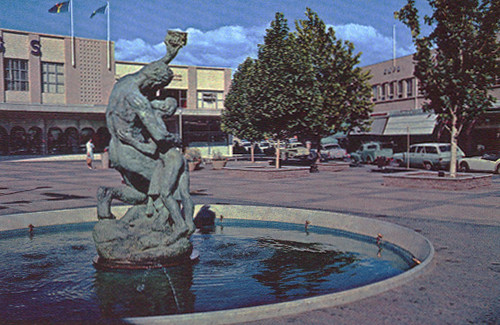
John Dowie’s Father and son, Garema Place, 1960s.
The unluckiest colour
Dear Mr Ali
Have you ever pondered the idea that green is an unlucky colour? I first heard it years ago from a babbling sports-caster, referring to green racing cars. It was one of those lines that just defecate out of these commentators as if slender moments of quiet lead audiences to distraction and end in a docked pay-check. I guess there’s a sub-class of broadcasters who never fully appreciated the transition from radio to TV. Do you mind if I call you Muhammad? Considering you’re in heaven now I’m sure we can be more relaxed with protocol.
Some time after hearing about it being an unlucky colour for racing cars, I learned there’s a general superstition about the colour green. I’m a bit skeptical. From the evidence I’ve gathered, green might be unlucky for some people, but there’s equally enough evidence that it’s lucky for others.
The luckiness or otherwise of green is a particularly salient question at the moment, with Australia competing at the Olympics in Rio. Our national colours reflect the green and gold of the wattle, our national emblem. At recent Olympics, inspired by an eternally over-optimistic Australian media, both the team and the populace have been left feeling despondently under-endowed with gold. Muhammad, as an Olympian with an extraordinary tale to tell about your own gold medal (even by Olympic standards), I’m sure you can appreciate how emotive this can be for some people.
I’ve observed that most Aussie team uniforms are predominantly gold, with little more than highlights in green. Perhaps what’s needed is to shift the balance in athletes’ attire toward green, thus conjuring a greater amount of inward bound gold due to the tendency for equilibrium in the natural order of things.
It’s worth remembering that green and gold only became Australia’s official national colours in 1984. Blue and gold was one alternative under consideration at the time. If, with objective, evidence based, peer reviewed science we could prove a converse relationship between green and luck, then I’d say there’s a case for revisiting that decision. It’s a matter of personal preference I know, but I think blue and gold are a more fetching combination. But I won’t let that smoke my objectivity.
I don’t know the origins of the superstition as it pertains to green racing cars. The Bentleys of the 1920s and 30s and the Jaguars of the 1950s and 60s are most
often associated with a shade of green peculiarly attributed to the British, and both marques enjoyed long periods of domination over the competition. As did Mercedes, yet their silver cars ultimately had the worst luck in motor racing history, crashing at the 1955 Le Mans and killing 83 spectators and driver, Pierre Levegh, and injuring many more. Mercedes gave racing away for decades after that.
Dick Johnson’s crash during the top-ten shootout the day before Bathurst 1983 would support the proposition that green race cars are bad luck. Johnson’s major sponsor back then was our lately retired statesman, Ross Palmer. Johnson’s cars were liveried to spruik Palmer Tube Mills trade-marks. Thus you had Tru-Blu through 80-82, and Greens-Tuf in 83-84.
Though externally and mechanically similar to the XD Falcon that preceded it, in which Johnson had won Bathurst in 1981, the XE Falcon of 1982-1984 brought one major technological advance. The origins of the XD’s leaf-spring rear suspension could be traced to horse-drawn carriages, so the XE’s new trailing arm suspension with watt’s linkages represented generational change. I won’t bore you with the engineering principles. Suffice to say that the physics are sound. In the mum and dad road car it really did result in better ride, handling and endurance – although the overuse of these terms by marketeers makes it easy to overlook. Of course, independent rear suspension, which is current orthodoxy, was still a long way off.
The bright, titanic, Greens-Tuf Falcon handled a bit ‘taily’ during Johnson’s 1983 hot lap. Johnson clipped the wall coming out of Forrest’s Elbow and a tonne and-a-half of Kermit-green horsepower hopscotched, tumbling into the trees and landing in a tangled wreck.
RIP Greens-Tuf 1
Johnson acquired a replacement car from a back-of-the-grid amateur racer, who in those days could still enter the Bathurst race (much to the irritation of some professionals, most vociferously, Johnson), and his mechanics battled to put years of development work into it overnight. Local TAFE apprentices squirted the now iconic Greens-Tuf livery onto it, and Johnson was miraculously on the grid for the start of the race. I always have this image of a pit-crew dude with green paint-splotches on his palms after pushing the tacky car out of the shed, though that again is borrowed from the imagination of one of those commentators who wittily invented it to evade silence.
Johnson himself bemoaned the lack of downforce provided by Ford’s homologated rear spoiler design. Whether it was that, Muhammad, or the lead time in coming to grips with a whole new suspension, don’t you think a technical explanation would be at least as likely as the colour of the paintwork? Not to mention human error and human imperfection.
In his Greens-Tuf livery, Johnson went on to win the Australian Touring Car Championship in 1984. His unluckiest Bathurst was undoubtedly 1980, when he qualified in pole position, but his Tru-Blu Falcon crashed early in the race after hitting a rock, thrown on the track by one of the lobotomised spectators who dominate the sport’s fan-base.
Muhammad, though you declared it yourself, many would agree you indeed have good claim to be considered the greatest in your sport. To my knowledge you never wore green trunks. You almost invariably wore white trunks with a black stripe. The notable exception was your fight with Joe Frazier, forty-five years ago this month, when you wore red crushed velvet trunks with white stripes. Frazier wore his signature green trunks, and for that fight, which has gone down in posterity as ‘The Fight of the Century’, Frazier’s green trunks were especially lush, with gold stripes, and a gold floral pattern which looked almost leopard-skin in effect. You and Frazier went fifteen rounds, and Frazier won on points. If we asked Joe Frazier, who for convenience we’ll say is also in heaven, I bet he’d say green was his good luck colour.
This is where it gets complicated, because you fought Frazier three times. For your 1974 bout at New York’s Madison Square Garden, you were back in your white trunks with black stripes, whereas Frazier had forsaken his green trunks for white, with flamboyant zig-zagged patterned openings over the thigh. Muhammad, you won on points after 12 rounds.
To summarise: in 1971 Frazier wore his signature green, you went red with white instead of your favoured white with black, Frazier won. In 1974 Frazier experimented with non-green trunks, you wore your white with black, you won. It’s tempting to conclude at this point that we each have our own lucky colour.
Finally we arrive at the ‘Thrilla in Manilla’ in 1975, your third and final confrontation with Smokin’ Joe Frazier. Importantly, for this bout, you appeared in your regular white trunks, and Frazier in his regular green.
You went out like a wrecking ball in the first few rounds, capitalising on Frazier’s reputation for being slow to get his mojo. Then you settled into your rope-a-dope strategy, leaning right back on the ropes and defending, for your opponent to tire himself taking shots. Like some American ballet, this oddly complemented the Frazier camp’s tactic to work on disabling your body.
Despite both stratagems, in round 6 you took a succession of lethal right hooks to the head that would’ve ended any other fight. Though you remained standing, people there said you went visibly stiff, as though mildly paralysed.
With your lungs and your skin broiling in the Quezon tropics, you and Frazier tussled savagely for 14 rounds, before the damage you’d inflicted in the first 3 finally stopped him. With his face a fluid-filled vacuum-pack, poor Joe could no longer see out either of his eyes. With Joe now a hundred kilogram slab of meat, trainer Eddie Futch stopped it before you took the ring for the final round. You’d defended your title with a technical knock-out.
You and Joe Frazier had finally met in your respective colours. That day though, Muhammad Ali, I don’t think was lucky for either of you.
Yours sincerely
Mark
Canberra haiku
はなびら落ち
春かすみ風
夢消える
amid petal fall
with September’s blearing wind
dreams are swept away
Redundancy a year on…
A year since I finished with the NSW Government I’ve managed to scramble my way through a Masters in International Relations, and I was rewarded with excellent results. Two months since my last exam I’m still looking for work but I have a really hot prospect this Friday so – fingers crossed.
Some might misinterpret what I’m about to write as sour grapes, but no, I’m very happy to have moved on and I volunteered for the opportunity. I could have stayed and been part of the new structure, there were many opportunities and I would have been given a place, but to be honest I was burnt out. Secure from the vantage of a year’s distance I can’t help making some observations.
Public sector executives love buzzwords and buzz-phrases (a crutch to mask their uncertainty), and every one of them adds their personal stamp with a restructure. My old branch, renamed Business Information Services or BIS, was remade along the lines of the cutting edge “SFIA” framework (can’t remember what the acronym stands for, something forgettable). My position, my boss’s, and some of my colleagues’, mandated under NSW legislation, were not known to exist within the SFIA framework. However, four additional Senior Executive roles were.
A year on, my manager’s old job, my old job and one of my colleagues’ jobs have all been advertised in the past few weeks. I guess someone worked out er… who’s going to do the work?
One year is coincidentally the same period which must pass before you can be re-hired without having to pay back any of your redundancy package. As an IT system administrator, in the past I have literally reinstated a person’s system access 1 year and one day from the date of their redundancy.
BIS ended up with six Senior Executives covering functions previously covered by 1 and-a-bit, and the merged establishment stayed steady at 113. At least in the BIS (IT) part of the organisation there was no need for the O’Farrell/Baird Government’s imperative “efficiency dividends”. The outcome was in fact the opposite of what the O’Farrell Government set out to do. That is to say it became more, not less top-heavy, which is consistent with the productivity killing and revenue flushing experiences during the continuous ‘personal stamp’ restructures under the previous incompetent Labor Government’s musical chairs of departmental executives.
I remember a meeting when a colleague pointed the new CIO toward the O’Farrell Government’s Public Service Commission review which spelled out the framework and the context of the restructure (in which the CIO had been the second hire after the Department Head, and thereafter was supposed to be an implementer), and my colleague was belittled like he was being a bit obsessive.
Roles within the new structure were formulated with multiple capability frameworks, because again, the same executive was ignorant that the NSW Public Service Commission was already implementing a capability framework, and thus thought he was very original in implementing another one, so that the two were overlaid, making the new “role” descriptions so abstract as to be meaningless. If it weren’t for the additional info some astute managers put into job advertisements, in many cases you literally could not tell what the job was. Managers with responsibility for functions of which they had some experience fielded absurd questions from confused prospective applicants, while managers with no experience of their new functions just added to the confusion. At all levels numerous people ended up with responsibilities for which they had no experience, knowledge or capabilities.
A year later those people are still being shifted, and the football team of new Senior Execs are dusting off old “position” descriptions and re-hiring deleted positions (the Government changed the terminology from “position description” to “role description” because it apparently infers less ownership on the part of the occupant).
And, in typical public sector fashion, the genius responsible, the guy who created a divisional structure based on some IT consultancy’s licensed (ie. it was paid for) snake oil methodology fit for nothing but a good brochure, who was hired from interstate and missed the Premier’s brief on what the restructure was for, and couldn’t be bothered to read it when it was brought to his attention, and did the complete opposite, shifting the head count toward more senior levels, displaying complete incompetence and leaving absolute chaos in his wake, has added it to his CV as another brilliant success, and already moved on to an even higher senior executive job.
Anybody would think Labor were still running the joint.




